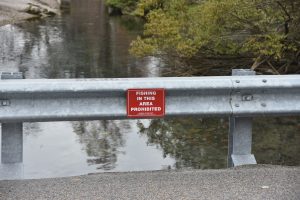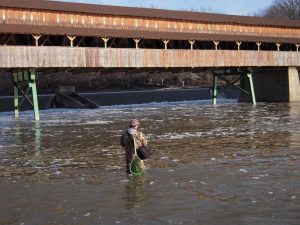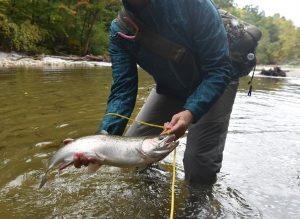
A give-and-take effort reaps rewards for anglers
In the past decade, steelhead fishing on Lake Erie has been heating up and for good reason: wildlife officials in Michigan, Ohio, Pennsylvania and New York have worked non-stop, and cooperatively, to ensure healthy populations of this super-prized and super-beautiful fish.
The effort has become so successful that Lake Erie’s southern tributaries have earned the nickname “Steelhead Alley.”
Steelhead, also known as rainbow trout, are members of the salmon family, and are often identified by their wide body-long iridescent stripe, hinting at pink-blue-green-orange-red flecked with a striking field of dark spots. They’re also known for their amazing fighting power and habit of breaking water multiple times after being hooked.
While many anglers never keep the steelhead they land, instead opting for quick release and maybe a quick photo, many anglers eat them – probably because they’re pretty darned tasty.
But it turns out they’re nothing new: fisheries managers first stocked steelhead from California’s McCloud River in Lake Erie tributaries back in the 1880s. And while various types of salmon have been stocked off-and-on during the last century, the Lake Erie steelhead fishery is definitely at one of its highest points.
Ed Eisch, fish production manager for the Michigan Department of Natural Resources, said his state has a great naturally reproducing population of fish in the Little Manistee River.
“We don’t stock the steelhead in the Manistee,” he said. Those fish, he explained, all reproduce naturally, and in great numbers. That allows Michigan to supply others, like Ohio, with steelhead.
“There’s something special about steelhead for sure, when those bright silver fish hit the river that really gets people excited. They’re definitely extremely popular throughout the Great Lakes region. It’s a hugely sought-after species here in Michigan.”
All for one and one for all: States share fish and eggs
But steelhead aren’t free for Ohio, Eisch explained. They cost a lot, and Ohio fisheries managers have to pony up. Each year, they provide Michigan with what’s called “channel cats,” he said, referring to the slang term for channel catfish, “for some of our lakes for a fishery, and for some of our lakes to control stunted panfish populations.”
While trading channel cats for steelhead seems like a no-brainer rip-off, with Ohio coming out the winner, Eisch said that’s not so.
“It’s kind of standard practice for all the states in the Great Lakes region to help each other out with eggs and fish as needed. We feel that Michigan, being surrounded by the Great Lakes, we have a plethora of fisheries available to us,” he explained. “We provide coho and chinook eggs to Illinois and Indiana on an annual basis. We swap our Michigan strain of Little Manistee steelhead to Indiana for a number of the summer runs of Canadian steelhead. We do that with muskies as well. It’s kind of a really cool cooperative thing that goes on.”
“It’s a species (channel cats) we don’t have the capacity to rear right now, so it really helps us out,” he said.

Signs just downstream from the Castalia Fish Hatchery help curb anglers’ urges, Photo by James Proffitt
According to Eisch, the whole cooperative spirit among the different agencies is kind of a rare thing nowadays in government. “It’s something I’m kind of proud to be a part of.”
Eisch said it didn’t really dawn on him how special the alliance was until he gave an interview earlier this year, and a reporter was stunned there could be such a cooperative spirit between agencies in different states.
“For me it’s like second nature,” he said. The whole time, my whole career, it’s something we’ve always done as a matter of course. You just never know: when times are fat for you that’s great, and if another state is struggling and if you help them out that means they’re all the more willing to help you out. It’s a give and take thing with all the Great Lakes states.”
Last autumn, Wisconsin helped Michigan out with chinook. This year, Michigan is providing them with coho eggs. It appears, thankfully, that some fisheries management issues in the Great Lakes transcend budgets and politics. And for anglers, and fish, that’s a great thing.
Pennsylvania, like other Great Lakes states, prizes their fish – and they’re typically home-grown.
Steelhead angling is a big draw
“It’s very big, it’s one of our most popular programs in the Lake Erie tributary system if not the most popular,” said Chris Coon, Pennsylvania’s chief of the Division of Fisheries Management. “Certainly there wouldn’t be much for recreational trout angling opportunities if the steelhead program weren’t in effect.”
While Pennsylvania has just one county that borders Lake Erie, it aims to get its bang for the buck, with aggressive stocking programs. More than 1.5 million rainbows were stocked in 2018, with most in its tributaries.
“It draws a lot of angler attention and use, particularly this time of year,” Coon said. “I’ve been meaning to go myself, but just haven’t had a chance yet this autumn.” But, Coon said, he intends to soon.
In Ohio, the state stocks about a half million steelhead each year. Eighty percent are stocked in Lake Erie tributaries, with about 100,000 rainbows distributed to inland ponds lakes and reservoirs. Those fish that don’t migrate out of streams and into Lake Erie, returning later to spawn, are considered rainbow trout. The migrating fish are considered steelhead, though the two are in fact the same fish. Their behavior separates the two.
Paul Liikala’s been fishing since the age of two, when he desperately sought to catch fish in a puddle in his driveway in Perry, Ohio on Lake Erie. Two years later his father introduced him to fishing where there were actually fish. “That was 68 years ago,” he said. “You do the math. And I’ve been chasing steelhead since the 70s.”
Liikala’s been writing about fish and fishing almost as long as he’s been fishing.
“Nowadays, the fish appear in streams in the autumn and stay until spring,” Liikala said. “I fish for steelhead through the winter.” He described fish that have come in straight from the lake as appearing as a more silver, vibrant, lighter shade. Once they hang in streams for a while, they become darker, taking on the darker hues of streamside surroundings.
Mostly catch-and-release, but still plenty of catch-and-eat
Tens of thousands of midwestern anglers hit the lake’s streams each year for steelhead, donning waders and often armed with fly rods. But specialized equipment isn’t necessary to catch steelhead.
“In the autumn you could be throwing spinners in harbors or off docks, that’s one easy way to get started,” explained Liikala. “Another traditional entry point is a spinning rod, bobber, split shot and hook.” He said small jigs tipped with maggots or waxworms is great, and so are tiny bags filled with salmon or trout eggs drifted with a float.

An angler plies the waters of the Grand River in Geneva, Ohio, Photo by Paul Liikala via James Proffitt
“You can get in the water with farm boots, too,” Liikala said. “And plenty of people fish from the piers and break walls.” He added that that the longer the rod the better, and a fluorocarbon leader is definitely a big plus.
While many people who regularly fish for steelhead rarely keep any, many anglers do. “It’s their choice,” Liikala said. “I’ll be honest I keep a few steelhead every year because I want the eggs. (He uses the eggs to make spawn sacks, which can be frozen and used for bait.) And I have a couple friends that really like the taste of steelhead.”
Why are steelhead so special?
People who aim for steelhead love the fight, Liikala said. “Once you set the hook you’ll immediately find out if you had your drag set right,” he said. “Because if you didn’t you’ll be able to watch your fish break water and break your line at the same time.”
Featured Image: A tiny selection of Julie Szur’s flies, Photo by James Proffitt







